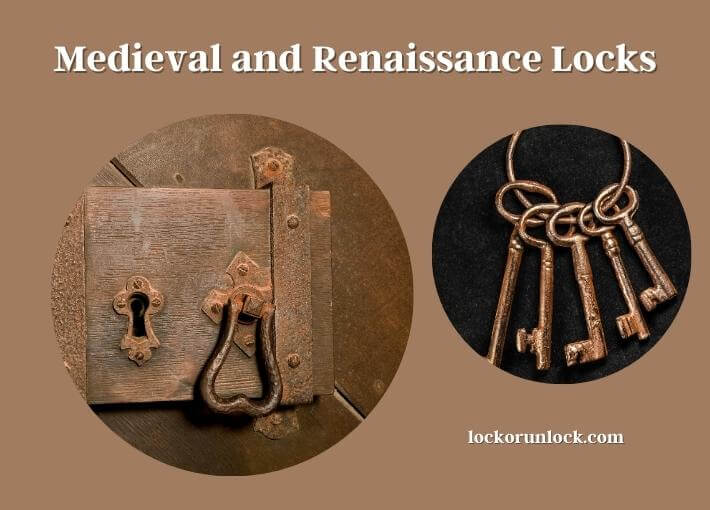Locks are an essential part of our daily lives, serving as a means of securing our belongings, protecting our homes, and providing a sense of safety and security. The concept of locks has been around for thousands of years, evolving from simple wooden mechanisms to complex digital systems. The evolution of lock technology is a testament to our desire for safety and protection, and it has played a significant role in the development of human civilization.

Locks have been used throughout history by various cultures and civilizations, from ancient Egypt to modern-day America. While the materials and designs of locks have evolved over time, their primary purpose has remained the same – to provide security and protection for our valuables.
Ancient Locks
Ancient locks were the first form of lock technology and can be traced back to over 4,000 years ago in ancient Egypt. These locks were made of wood and used a simple pin tumbler system, consisting of a bolt and a key. The key was a wooden stick with pegs that corresponded to the pins in the lock. When the key was inserted and turned, the pins would be lifted to a specific height, allowing the bolt to be pushed open.
Ancient Roman locks were made of iron and were more complex than the earlier Egyptian locks. They featured a keyhole that was surrounded by wards, which were protruding pieces of metal designed to prevent unauthorized access. The key was shaped to fit around the wards, and the pins inside the lock were designed to correspond with the key’s shape. The Chinese also had their own unique lock system made of bronze, which used a series of rotating discs to unlock the mechanism.
Materials used in ancient locks varied widely depending on the region and time period. In ancient Egypt, locks were typically made of wood, while in ancient Rome, iron was the preferred material. Bronze was commonly used in ancient China.

Advancements in ancient lock technology included improvements in materials and designs. The ancient Greeks and Romans were the first to use warded locks, which featured intricate internal mechanisms that required specially shaped keys to unlock. The warded lock was the dominant form of lock technology until the 18th century when the tumbler lock was invented.
Despite their simplicity, ancient locks were effective in securing homes and valuables, and their basic design principles continue to be used in modern-day locks. These early locks set the foundation for the development of modern lock technology and provided a basis for future advancements.
Medieval and Renaissance Locks
During the Medieval and Renaissance periods, lock technology continued to evolve, with advancements in materials, designs, and complexity. Locks became more elaborate and decorative, reflecting the status and wealth of their owners. As technology progressed, locksmiths experimented with different mechanisms and key designs, leading to the creation of more secure and reliable locks. Today, we can take a journey through time with locks, admiring the intricate craftsmanship of antique locks and appreciating the modern innovations that have made them more convenient and secure than ever before. Whether it’s the ornate designs of a medieval lock or the high-tech features of a smart lock, the evolution of lock technology tells a fascinating story of human ingenuity and the perpetual quest for security.
One of the most notable advancements during this time was the introduction of the lever tumbler lock in the 14th century. This type of lock featured a series of levers that had to be lifted to a specific height by a key in order to unlock the mechanism. This design made it much more difficult for lockpicking and became the dominant form of lock technology until the 19th century.

In the Renaissance period, locks became more ornate and decorative, with intricate designs and engravings. Locksmiths became highly skilled artisans, and locks were considered valuable works of art. Locks were also used to showcase the technological advancements of the time, with complex and intricate mechanisms that were often designed to be as secure as possible.
One notable example of Renaissance lock technology is the Bramah lock, invented by Joseph Bramah in 1784. This lock featured a series of rotating discs that had to be aligned correctly by the key to unlock the mechanism. It was considered one of the most secure locks of its time and remained unpicked for over 60 years.
The Medieval and Renaissance periods also saw the development of lockpicking as a skill. Thieves and locksmiths both became adept at picking locks, leading to the need for increasingly complex and secure lock designs.
The Medieval and Renaissance periods were a time of significant advancements in lock technology, as well as an appreciation for the beauty and craftsmanship of locks. These periods laid the foundation for the development of modern lock technology and continue to inspire innovation in lock design today.
Industrial Revolution and Modern Locks
The Industrial Revolution marked a turning point in lock technology, with the development of mass production techniques and the use of new materials. Locks became more affordable and accessible to the general public, leading to widespread use in homes and businesses.
One of the most significant advancements during this time was the invention of the pin tumbler lock by Linus Yale Sr. in 1848. This design used a series of pins that had to be lifted to a specific height by a key in order to unlock the mechanism. The pin tumbler lock became the dominant form of lock technology and is still widely used today.

The 20th century saw further advancements in lock technology, with the introduction of combination locks and electronic locks. Combination locks use a series of numbers or symbols that must be entered in the correct order to unlock the mechanism, while electronic locks use a keypad or card reader to grant access.
Modern locks also incorporate new materials and technologies, such as biometric scanners and smart locks that can be controlled remotely using a smartphone app. Biometric locks use fingerprint (Fingerprint locks have become increasingly popular as a convenient and seemingly secure way to protect personal belongings, such as smartphones, laptops, and even homes) or facial recognition technology to grant access, while smart locks can be programmed to allow access for specific individuals at certain times.
Despite these advancements, lockpicking remains a concern, and locksmiths and security experts continue to develop new techniques and technologies to improve lock security. In recent years, 3D printing has also emerged as a potential threat to lock security, as it allows individuals to create their own keys and locks using digital designs.
The Industrial Revolution and the modern era have seen significant advancements in lock technology, making locks more accessible and secure than ever before. However, as technology continues to evolve, so do the methods of lockpicking and the need for continued innovation in lock design and security.
Famous Locks and Lockpicking
Throughout history, there have been many famous locks and instances of lockpicking. Some of these examples have become part of popular culture and are well-known around the world.
One of the most famous locks is the Chubb detector lock, which was invented in the 19th century by Jeremiah Chubb. This lock was designed to be unpickable and was famously tested by Alfred Charles Hobbs, an American locksmith who successfully picked the lock after 51 hours of work. The Chubb detector lock remains a symbol of advanced lock technology and security.
Another famous lock is the Great Seal of the United States, which is protected by a series of mechanical and electronic locks. The design of these locks is top secret, and only a few individuals are authorized to access them.
In popular culture, lockpicking has been portrayed in many movies and TV shows, with characters using various tools and techniques to break into locked doors and safes. While these portrayals are often exaggerated, they have contributed to a fascination with lockpicking and lock technology.
Lockpicking has also been used for criminal purposes, with thieves and burglars using specialized tools and techniques to gain access to locked buildings and safes. This has led to increased emphasis on lock security and the development of new technologies and techniques to prevent lockpicking.
Despite efforts to improve lock security, lockpicking remains a challenge, and locksmiths and security experts continue to develop new methods and technologies to improve lock design and prevent unauthorized access.
While locks have become more advanced and secure over time, the challenge of lockpicking remains, and continued innovation is needed to stay ahead of potential threats.
Modern Era of Lock
The modern era of locks is characterized by a wide range of advanced security features and technologies that are designed to provide enhanced protection against unauthorized access. These features include high-security keyways, electronic locking mechanisms, biometric authentication, and more.
High-security keyways are designed to prevent picking and bumping attacks, which are common methods used by intruders to gain access to locks. Electronic locking mechanisms provide additional layers of security by using advanced encryption algorithms to protect against hacking and other cyber threats.
Biometric authentication is another popular feature of modern locks, which allows users to access a lock using their unique physical characteristics such as fingerprints or facial recognition. This provides a highly secure and convenient method of access control that eliminates the need for keys or codes.
Other features of modern locks include anti-drill and anti-pick plates, reinforced steel construction, and tamper-resistant designs. These features are designed to make modern locks highly resistant to physical attacks, providing enhanced security for homes, businesses, and other sensitive areas.
The modern era of locks has brought significant advancements in security technology, providing enhanced protection against unauthorized access and helping to keep people and property safe.
Wrapping Up a Conclusion
Locks have been an important part of human history, providing security and protection for homes, businesses, and valuable possessions. From ancient locks made of wood and rope to modern electronic locks controlled by smartphones, lock technology has evolved significantly over time.
The development of locks has been driven by a desire for security and privacy, as well as a need to prevent theft and unauthorized access. Locks have been used in various forms throughout history, with each era contributing to new advancements in lock design and technology.
While locks have become more advanced and secure, the challenge of lockpicking remains. Criminals and thieves continue to use specialized tools and techniques to gain access to locked buildings and safes, leading to increased emphasis on lock security and the development of new technologies and methods to prevent unauthorized access.
As technology continues to evolve, so too will the methods of lockpicking and the need for continued innovation in lock design and security. The future of lock technology is likely to incorporate even more advanced features, such as biometric scanning and artificial intelligence, to provide even greater security and convenience for users.
Some Common Questions
When Were Locks Invented?
Locks have been used for thousands of years, with evidence of simple wooden pin locks dating back to ancient Egypt and Babylon around 2000 BCE. However, more sophisticated mechanical locks similar to what we use today were developed during the Roman Empire in the first century BCE.
Who Invented the First Lock?
It’s difficult to determine exactly who invented the first lock, as they were likely developed independently by various ancient cultures. However, the oldest known lock was found in the ruins of the Palace of Khorsabad in Assyria and dates back to around 704 BCE.
What is the Most Secure Type of Lock?
The most secure type of lock depends on the specific use case and level of security required. For example, a high-security deadbolt lock with a reinforced strike plate and long screws is often recommended for securing residential doors, while a combination of multiple types of locks and security systems may be necessary to protect commercial properties or sensitive information.
Are There Any Famous Locks in History?
Yes, there are several locks that are famous for their historical significance or unique design. One of the most well-known is the Great Wall of China’s “lock gate,” which was a massive wooden gate that could be closed to block invaders. The Chubb Detector Lock, invented in the 19th century, was also famous for its complexity and was considered unpickable for many years. Today, it’s displayed at the Science Museum in London.
